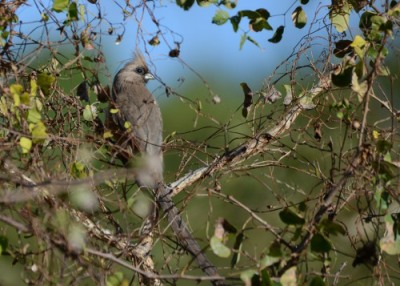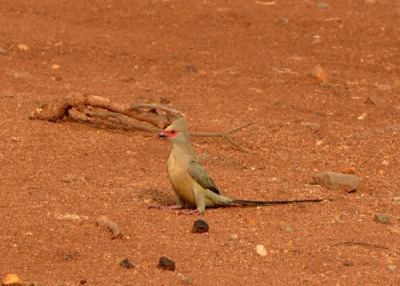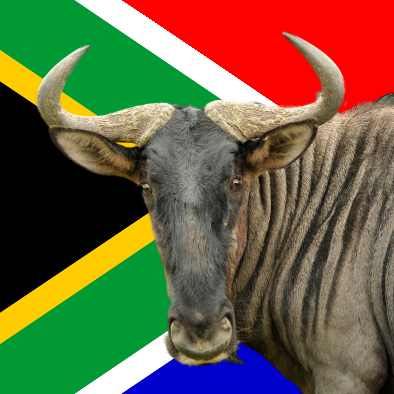Mousebirds
Afrikaans name: Witkruismuisvoël

White-backed Mousebird
Photo © AdobeStock
Mousebirds - the clowns of the bird world
Did you know that mousebirds are the only order of birds that are confined to Africa? In fact, there are only 6 surviving species left and fossil records indicate that there were once many more species. Out of the 6 species there are 3 that are found in South Africa. These are the Red-faced Mousebird, Speckled Mousebird and the White-backed Mousebird. Elsewhere in Africa you may encounter the Red-backed Mousebird, White-headed Mousebird and Blue-naped Mousebird.
Mousebirds are enchanting birds and to me they are the clowns of the bird world. When scrambling around in trees and bushes they cling to twigs with their short legs and find themselves in all sorts of awkward positions. Their "mousey" colouration led to their being called mousebirds.

Speckled Mousebird
Photo © Steven Herbert
The 6 species of Mousebirds are all very similar in looks. They are all basically grey in colour, have long tails and are between 30 and 35 cm in length. They are found in small flocks which go from tree to tree other as a group (e.g. Red-faced Mousebirds) or one by one (e.g. Speckled Mousebird). They often make a chattering or whistling sort of call which seems to keep them in contact with each other. Species such as the Red-faced Mousebird are able to fly quite fast.
At night they sleep bunched up together presumably to keep warm. They hang vertically from a perch with head up and tail down. They are able to conserve energy while sleeping by going into a torpor (similar to mammals that hibernate) which allows them to reduce their body temperature by a significant amount.

Red-faced Mousebird
Photo © Steven Herbert
Mousebirds can be found in a variety of habitats. These include open woodlands, savanna, thickets, orchards, parks and gardens. Their love of fruit makes them a bit of a pest for fruit farmers. They are sometimes seen on the ground where they enjoy a dust bath or just to sun themselves. They may also be looking for fallen food.
They eat a wide variety of foods including soft fruits, berries, seeds, nectar and even some juicy leaves. On rare occasions they have been observed to eat insects. Some people who have bred mousebirds in captivity have observed them feeding ant pupae to their young. Sometimes they will swallow some sand which presumably provides them with minerals.

Speckled Mousebird
Photo © Steven Herbert
While mousebirds spend most of their time feeding and roosting communally this is not true when they breed. They make a bowl-shaped nest in a bush or tree. They normally lay between 2 and 4 eggs, but larger clutches have been found and it is believed that this is the result of other females laying their eggs in the same nest. The eggs are white or cream in colour and they sometimes have reddish blotches on them. Incubation takes around two weeks during which both sexes will take turns at sitting on the eggs. Both parents tend to the chicks.
Mousebirds are kept and bred in captivity in some places and they are apparently quite at home in this restricted environment. They can also be quite tame and kept as pets if trained from a young age. Although it is not a good idea in general to keep wild birds in captivity, most of the species of mousebird are common in the wild so their populations aren’t threatened.
Species of Mousebird found in South Africa
Red-faced Mousebird
This species has an attractive band of red from its bill across its eye. They are around 34 cm in length. They are always seen in small flocks. Read more about the Red-faced Mousebird.
Speckled Mousebird
A common species in South Africa. They have an interesting habit of flying one by one between bushes or trees. They each wait for their turn before flying to the next bush. Read more about the Speckled Mousebird.
White-backed Mousebird
The White-backed Mousebird is most easily identified by its white bill with a black tip. They also have bright red legs while the legs of the Speckled Mousebird are pale red. They are very social and can often be seen preening each other. Read more about the White-backed Mousebird.
References and further reading
Ornithology - The Science of BirdsThis website features affiliate links, meaning we’ll earn a small commission if you purchase through these links.
Copyright Steven Herbert Projects, 2013 - 2025. All rights reserved.
